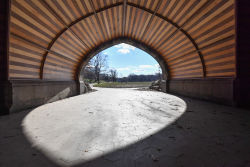Prospect Park
Terrace Bridge
When Prospect Park designers Calvert Vaux (1824-1895) and Frederick Law Olmsted (1822-1903) first planned the area surrounding Terrace Bridge, they imagined a restaurant and a series of terraces and arcades where visitors could enjoy music and lake entertainment. The area below Lookout Hill, in conjunction with the nearby Concert Grove, was to be the site of open-air concerts. Although the design was never completed, Terrace Bridge preserves their intention for this region of the park.
The first Terrace Bridge was a wooden structure built between 1868 and 1870. The wooden bridge lasted until 1890, when Vaux erected the present bridge. Terrace Bridge, the largest in Prospect Park, was Vaux’s last contribution. Six large steel arches, set in stone and brick, bolster this vehicle bridge. Both sides of Terrace Bridge feature pedestrian underpasses and circular stone carvings of “18” and “90,” for the year of completion.
Terrace Bridge spans the area of transition between the Lullwater and Prospect Park Lake. The Wisconsin Ice Sheet carved the terrain of the Lullwater and the Lake about 20,000 years ago. The glacier’s movement deposited tons of gravel and pebbles (for example, Palisades boulders found in Central Park), plowed up topsoil, and leveled the earth, filling in depressed areas with glacial till. The ice melted and left large depressions filled with meltwater, which created ponds and lakes called kettles. The Lullwater is a 16.8-acre wetland winding between the Nethermead, the Midwood, and the Ravine. Constructed in the 1860s, the 60-acre Lake is the largest lake in Brooklyn.
From the Terrace Bridge one can appreciate some of the natural features of Prospect Park. On the Breeze Hill side of the bridge, there is a unique Himalayan Pine (Pinus wallichiana), and the Lookout Hill side features a hybrid Oak tree (Quercus robur x petraea). The wetlands of Prospect Park are home to a wide variety of plant and animal life. Yellow Waterlilies (Nymphaea mexicana) float on the water under the bridge. Various frogs and fish like common carp (Cyprinus carpio), channel catfish (Ictalurus panctatus), largemouth bass (Micropterus salmonoides) and pumpkinseed sunfish (Lepomis gibbosus) inhabit the Lake and connecting waterways.
A few of the local and migratory birds that make their home in Prospect Park are the wood duck (Aix sponsa) and ruddy duck (Oxyura jamaicensis), mallard (Anas platyrynchos), gulls (Laridae family), black-crowned night-herons (Nycticorax nycticorax), green-winged teal (Anas crecca), buffleheads (Bucephala albeola), canadian geese (Branta canadensis) canvasbacks (Aythya valisineria), American black duck (Anas rubripes), double-crested cormorant (Phalacrocorax auritus), and great egret (Casmerodius albus).
Terrace Bridge is located along Wellhouse Drive, between Lookout Hill and Breeze Hill. The bridge rests at the edge of the Ravine District, a designated New York City Scenic Landmark. The New York City Landmarks Preservation Commission selected the district in 1975. The United States Department of Interior listed Prospect Park on the National Register of Historic Places in September 17, 1980, to preserve all the important features of Prospect Park.
Check out your park's Vital Signs
Clean & Safe
Green & Resilient
Empowered & Engaged Users
Share your feedback or learn more about how this park is part of a
Vital Park System











